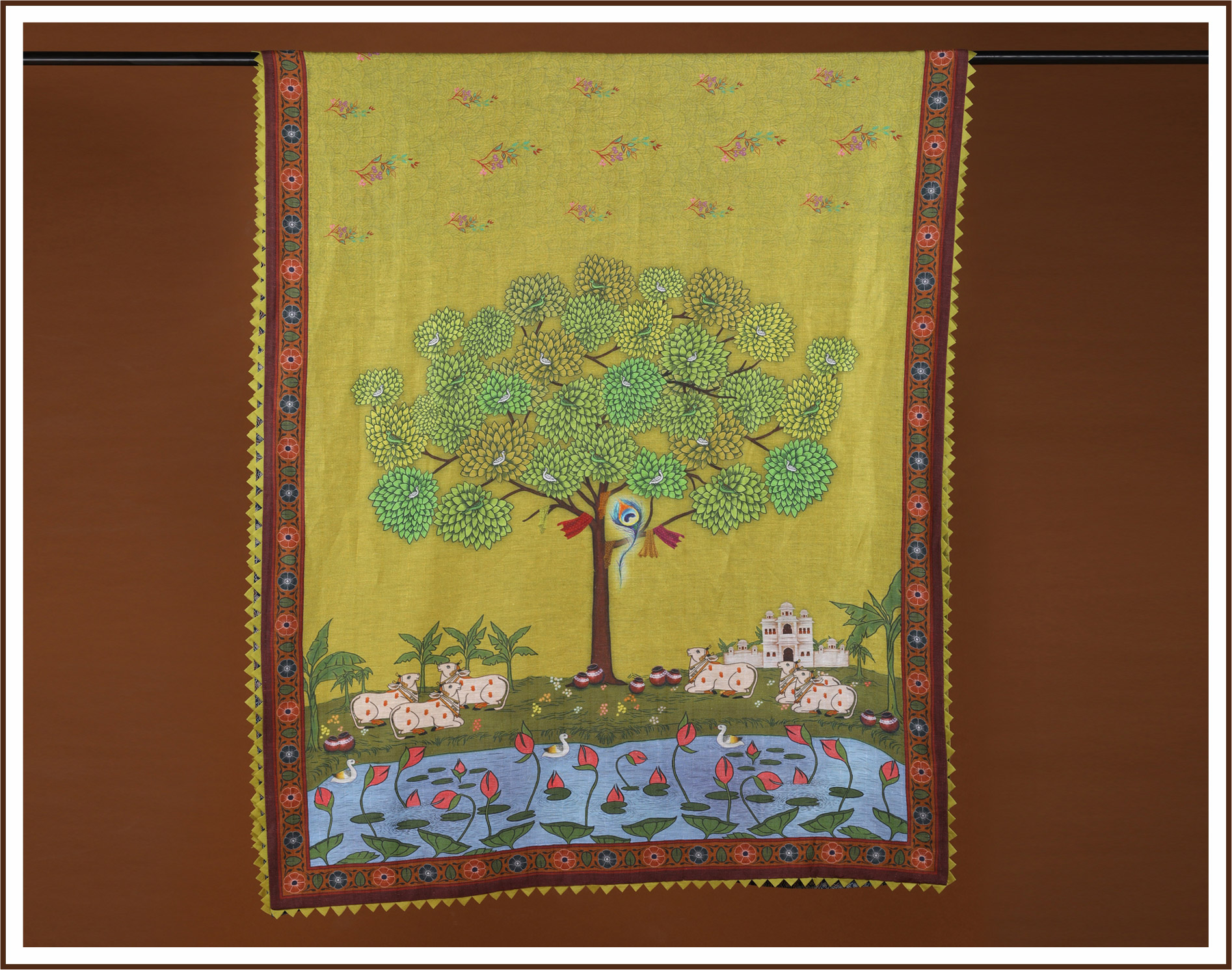

Label Pratham, born in 2011, emerged as the foremost textile and wearable art brand that interacted with the vast culture of Pichwai and transformed it to its accessible material culture that has become more recognisable today. At the start, over a decade back, Pichwai sarees were unheard of, which earned the founders of the brand the eponymous name, "Pichwai Couple". Being pioneers in bringing the art of Pichwai in wearable form, we are attempting to unravel the historical facts related to this sacred art in Did You Know series -
Shri Vallabhacharya, the founder of Pushtimarg, encountered the swarup of Shrinathji on Mount Govardhan, Mathura, UP. Shrinathji is considered to be a living embodiment of 8-year-old Lord Krishna, who is shown as lifting Mount Govardhan above his head with his left arm while holding his right hand by the waist. The deity was moved to its present-day location, Nathdwara, Rajasthan in 1670 & later a shrine known as "Shrinathji ki Haveli" was built in 1672.
At Nathdwara, Shrinathji is treated as a child and all the activities of the shrine commonly known as 'Shrinathji ki Haveli', revolve around the activity of a 7-year-old child. He is given treatment like shringar or food in a way just like a mother would do to her child. The devotees worship him with music, poetry, dance, drama & paintings. Shrinathji is the muse of Pichwai painting & is the inspiration for Pichwai tradition & culture. Keeping this in mind, Label Pratham is continuously maintaining the authenticity of Lord Krishna’s paintings.
Since Shrinathji is considered a living embodiment and not worshiped as an idol, the place where Swarup resides is known as 'Shrinathji ki Haveli'. This is the reason that there are no temples in Pushtimarg. The economy and livelihoods in Nathdwara town revolve around the Haveli.
The Haveli of Shrinathji in Nathdwara is modeled on the mansions of opulent Rajasthani kings and merchants who were meant to serve the familiar, domestic environment of Krishna's home in Vraj. The structure is very different from a regular temple & consists of multiple courtyards, associated temples, a labyrinth of rooms, courts, corridors, gardens, pools, halls, and kitchens. These alluring sceneries are the inspiration for the Shrinathji Pichwai paintings.
Pichwai, literally meaning "displayed at the back", is a decorative cloth painted, embellished, or embroidered, suspended behind Shrinathji's swarup in havelis. A Pichwai painting normally corresponds with the particular way in which Krishna's seva is being performed at a given time in the day.
Pichwai is a miniature form of art with minute intricacies and made with a lot of precision. One can see the seamless efforts of the artists. Even the smallest mistakes can be easily detected, so the artists have a definite posture of how to sit and make. Just like our artisans at Label Pratham, who work with precision, dedication and commitment.
A day at Shrinathji ki Haveli is divided into eight darshans. Each darshan is performed with its exquisite shringar (adornment), rag (poetry with music), and bhog (food offerings) and is planned with keen attention to the season, the time of the day, and the mood of the child God.
The main source of inspiration for making Pichwai used to be 'Haveli Sangeet', (devotional music sung during each of the eight daily darshans) or based on what the tilakayat (head priest) narrated to the artists. They then replicated that imagery, the sketches were approved and only then painted. This was the origin of Shrinathji Pichwai paintings.
A Pichwai is generally painted on a starched cotton cloth. The first stage in creating a Pichwai painting is known as 'tippan' where the first impression of the painting is laid down with the help of kalam (brushes made with horse and squirrel hairs) or charcoal pencil. The drawing is then coated with a layer of chalk or kharia as they call it locally. This ground seals the surface for later colors and sets the initial drawn image. Several coats are applied for cloth Pichwais while a single coat is applied for paper Pichwais.
The above mentioned are some of the facts that are related to the Pichwai paintings & art form. Label Pratham takes pride in keeping the tradition alive and providing artistic wearables, meticulously created with Lord Krishna's paintings and Pichwai paintings of Nathdwara. The "Pichwai Couple", Shweta & Prashant Garg have innovated a unique aesthetic of Pichwai, that is rooted in the original tradition while also employing contemporary metaphors. Today, we have accumulated under its umbrella the credit of working with multifarious artisanal traditions and weaving clusters, each lending its unique texture and design history to the sublime art of Pichwai.We welcome everyone to explore our solemn creations.
